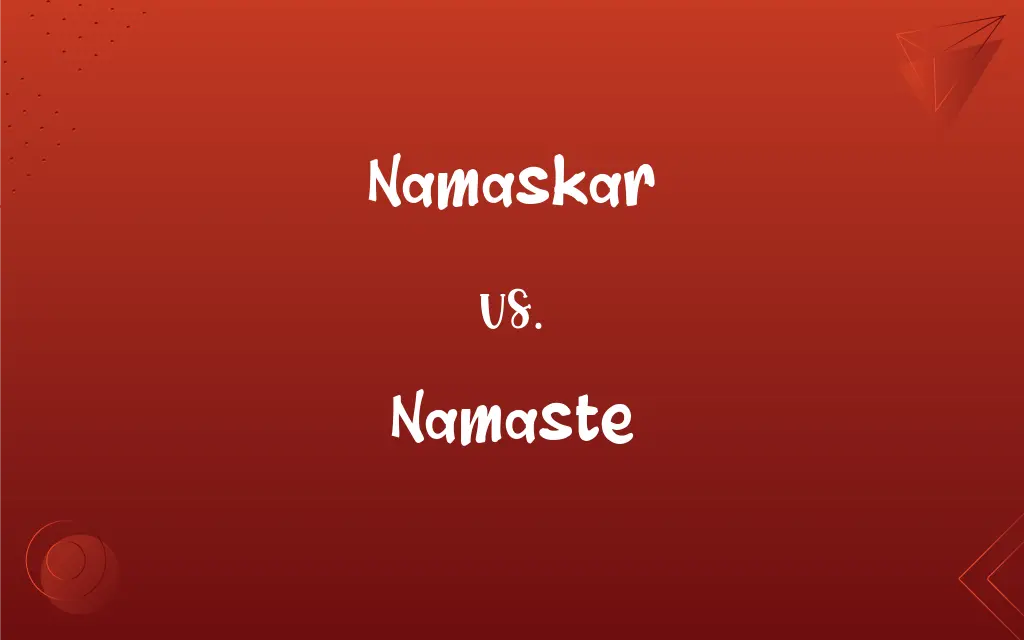Namaskar vs. Namaste: What's the Difference?
Edited by Aimie Carlson || By Harlon Moss || Updated on October 4, 2023
Namaskar and Namaste are both Indian greetings. While they're often used interchangeably, "Namaste" is more prevalent in North India, and "Namaskar" is more common in other regions.

Key Differences
Namaskar and Namaste are terms rooted in the rich cultural tapestry of India, denoting respect and greeting. Both words are derived from Sanskrit and signify a sense of reverence towards the person being addressed.
Namaste is often associated with North India, and it has seen global adoption, especially in the world of yoga and meditation. The word is formed by combining "Namas," which means 'bow' or 'reverence,' with "te," meaning 'to you.' Thus, Namaste can be translated as "I bow to you."
On the other hand, Namaskar is a slightly more formal term compared to Namaste and is prevalent in various parts of India. The word originates from "Namah," denoting 'salutation,' and "Kar," which means 'do or make.' Consequently, Namaskar essentially means 'I make salutation.'
While both words convey a sense of respect and are used to greet others, nuances might vary based on region and context. Nonetheless, both are emblematic of the Indian ethos of recognizing and honoring the divine in every individual.
Comparison Chart
Origin
Derived from "Namah" and "Kar."
Comes from "Namas" and "te."
ADVERTISEMENT
Usage Region
Widespread in various parts of India.
Predominantly North India and globally in yoga circles.
Formality
Generally more formal.
Often seen as less formal.
Meaning
"I make salutation."
"I bow to you."
Global Recognition
Lesser known internationally.
Widely recognized due to yoga and spiritual practices.
Namaskar and Namaste Definitions
Namaskar
A formal Indian greeting.
She offered a Namaskar upon entering the temple.
ADVERTISEMENT
Namaste
A term expressing deep respect or reverence.
She greeted the monk with a Namaste.
Namaskar
A salutation expressing respect.
At the beginning of the meeting, he started with a Namaskar.
Namaste
A Sanskrit word translating to "I bow to you."
Meeting her teacher, she said Namaste as a sign of respect.
Namaskar
A term symbolizing the act of bowing or acknowledging.
He gave a Namaskar to the elderly woman out of respect.
Namaste
Popularized globally through yoga.
At the end of the yoga session, everyone said Namaste.
Namaskar
Derived from Sanskrit, denoting reverence.
The teacher emphasized the importance of the word Namaskar.
Namaste
A common greeting in North India.
He said Namaste when he met his friend in Delhi.
Namaskar
Often used in religious or spiritual contexts.
Before the prayer, everyone gave a Namaskar.
Namaste
Represents the soul in one person recognizing the soul in another.
He believes saying Namaste is like recognizing the divine in each other.
Namaskar
A polite or respectful gesture of greeting or farewell widely used among Hindus and made by pressing the palms together at an upward angle in front of the chest and generally accompanied by a slight bow.
Namaste
Used especially among Hindus to express a polite or respectful greeting or farewell.
Namaskar
Used to express a polite or respectful greeting or farewell.
Namaste
A greeting only in Indian culture-related or New Age contexts and Indianized literature
Namaskar
(India) The use of the greeting in which one puts one's hands together and bows slightly; greeting with a namaste.
Namaste
The traditional greeting when saying the word namaste, with folded hands and a slight bow.
Namaste
In yoga, the pose associated with this word, usually with the flat hands held palms together, fingers up, in front of the heart and a slight bow.
Namaste
(intransitive) To utter "namaste".
The yoga instructor namasted, and the class began.
FAQs
What does Namaskar mean?
Namaskar means "I make salutation."
Are Namaskar and Namaste interchangeable?
While often used interchangeably, they have nuanced differences based on region and context.
How is Namaste used in yoga?
It's a common greeting or conclusion in yoga sessions, symbolizing respect and unity.
Is Namaste exclusive to North India?
Predominantly, yes, but it's recognized and used worldwide, especially in yoga.
Are these greetings specific to any age or group in India?
No, they're used universally across ages and groups.
Which greeting is more formal: Namaskar or Namaste?
Namaskar is generally perceived as more formal.
Is Namaskar common outside of India?
It's lesser-known internationally compared to Namaste.
What's the origin of Namaste?
It's derived from Sanskrit, combining "Namas" (bow) and "te" (to you).
How is Namaskar typically demonstrated?
Often with palms pressed together near the chest and a slight bow.
How do I respond when someone says Namaskar or Namaste?
You can reply with the same greeting.
What's the meaning of Namaste?
Namaste translates to "I bow to you."
Is Namaste also a physical gesture?
Yes, similar to Namaskar, with palms together and a bow.
Can I use Namaste outside of India?
Absolutely! It's recognized and appreciated in many parts of the world.
Why is Namaste popular in the wellness community?
Its spiritual undertones and association with yoga resonate with wellness practices.
Do these words have literal translations?
Yes, Namaskar means "I make salutation" and Namaste means "I bow to you."
Why has Namaste become globally popular?
Its association with yoga and meditation has propelled its global recognition.
Are these greetings religious?
They have spiritual connotations but are used in secular contexts too.
Which greeting is older: Namaskar or Namaste?
Both have ancient roots, making it hard to determine which came first.
Do both greetings have the same gesture?
Generally, yes: palms pressed together and a slight bow.
Is Namaskar used in any specific Indian rituals?
Yes, especially in religious and spiritual ceremonies.
About Author
Written by
Harlon MossHarlon is a seasoned quality moderator and accomplished content writer for Difference Wiki. An alumnus of the prestigious University of California, he earned his degree in Computer Science. Leveraging his academic background, Harlon brings a meticulous and informed perspective to his work, ensuring content accuracy and excellence.
Edited by
Aimie CarlsonAimie Carlson, holding a master's degree in English literature, is a fervent English language enthusiast. She lends her writing talents to Difference Wiki, a prominent website that specializes in comparisons, offering readers insightful analyses that both captivate and inform.
































































